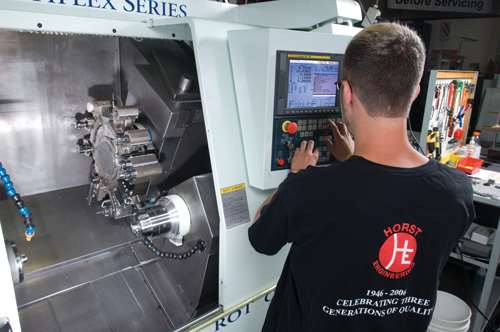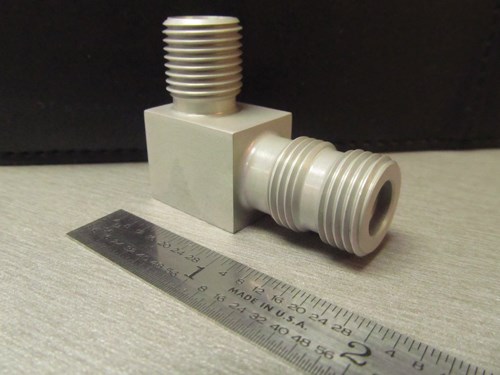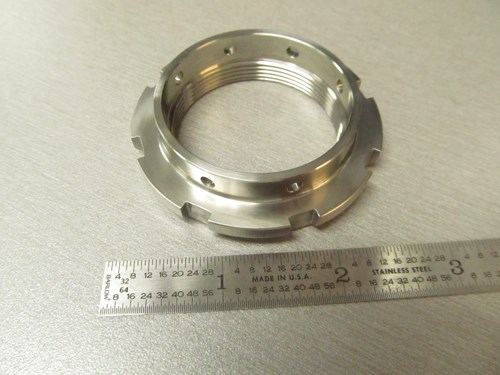High Mix, Low Volume Shop Redefines Throughput for Aerospace Parts
Many shops struggle with trial and error, but some companies are lucky enough to discover what works best for their application the first time around.
Producing increasingly complicated parts that require more tools than ever before is a challenge for many manufacturers. To keep up with the latest technology is the key to success. Many shops struggle with trial and error, but some companies are lucky enough to discover what works best for their application the first time around.
This is what happened to the third-generation contract manufacturer, Horst Engineering (East Hartford, Conn.). This company produces parts that are becoming more complex, requiring more tooling every year. It faces another challenge as well: a high mix of parts with low annual volumes. A long setup time is detrimental to any shop, so reducing change-over time was important to the company.
Featured Content
In August 2005, the company implemented Eurotech Elite turn-mill machines to produce a range of custom components for the aerospace industry, including fasteners, bushings, valve bodies, clevises, fittings, washers, flanges, rings, valve and pistons.
“The multi-axis Eurotechs have helped us increase the number of features completed in one machine,” says Allen Beaulieu, turning leadperson/CNC programmer. “This helps to improve throughput and mistake-proof the process.”
“Aerospace is always a challenge because it requires high precision, but is also a small lot size business,” says Scott Livingston, president and CEO. “There are certain components we make more frequently than others, but the low volumes still prevent us from optimizing our processes. We have more than 4,000 active, unique part numbers with an average lot size of less than 100 pieces. With such a range of product and customer requirements, we need a solution that gives us flexibility, speed and accuracy.”
According to Mr. Beaulieu, the company uses a variety of difficult-to-machine materials, and run at tolerances that push all of its machines to the limit. “More sophisticated processes and more complex machines mean more unusual machine problems, including wear and tear, compared with a traditional job shop or high volume shop. However, Eurotech’s service and engineering have always been there to help solve the challenges,” he says.
High Precision for Aerospace
The company manufactures a tee fluid fitting, a complicated part that requires special attention to detail. Parts such as these with multiple features have tighter control on positioning and relationship to other features. Timing of the machine spindle is critical. Complex machining, longer cycles, and more completely machined features have to be backed by a higher inspection level at the time of manufacturing. Though the part size is not considered large, they do require a variety of cutting tools to produce them. The machine turret is limited to the amount of tooling that it can hold so when processing and programing, it’s best to utilize every tool to its fullest capability. When milling large parts, the tool path often pushes the machine over the travel limits in the Y axis, so the tool path has to be clearly defined.
For Horst Engineering, the Eurotech machines have produced the precision that is required in aerospace, meeting the company’s needs. All of its machines’ controls have been dialed in to “super-precision” accuracy with 0.000010 resolution.
If it weren’t for the Eurotech machines, these parts would have to be machined in multiple operations; some operations would require special fixturing and holding methods. “Those alternate processes would create higher costs (tooling, fixturing, and so on), extended lead time, increased part queues, increased part handling and motion,” Mr. Beaulieu says.
Programming Offline for Complex Parts
Horst Engineering has had a lot of success with its offline programming solutions. With a high mix of parts, it is setting up equipment every day. The company started using PartMaker software for its Swiss-type machines, and then migrated to its Eurotech multi-axis platform. “Before this software integration, we were programming long hand, but now we are able to do a lot more with the solid models, and we are able to reduce redundant steps,” Mr. Livingston says.
“We can now go from solids right into their software, and then from the software right out to the machines, and the product is perfect the first time. This integration brought engineering and manufacturing in close ties to one another because everyone is now using the same model, and the product is coming out to the customer’s specifications the first time,” says Jim Bowtruczyk, director of product and process improvement.
Since its beginning in 1946, Horst Engineering has evolved and has come into new markets with the help of Eurotech multi-axis lathes. The machines have reduced steps in the company’s machining processes, while maintaining the high precision that aerospace parts require.
RELATED CONTENT
-
Getting More Production From Swiss Turning Centers
Buying a new CNC Swiss turning center is a substantial investment. For the best return, look closely for capabilities that enable the best utilization of the machine.
-
Keeping Watch on Small Parts
From watch parts to exotic medical applications, this shop takes on the world of micromachining.
-
How to Get More Efficient Production from Swiss-Type and Multitasking Machines
SolidCAM for multi-axis Swiss type and multitasking machines provides a very efficient CAM programming process, generating optimal and safe Mill-Turn programs, with dramatically improved milling tool life.









